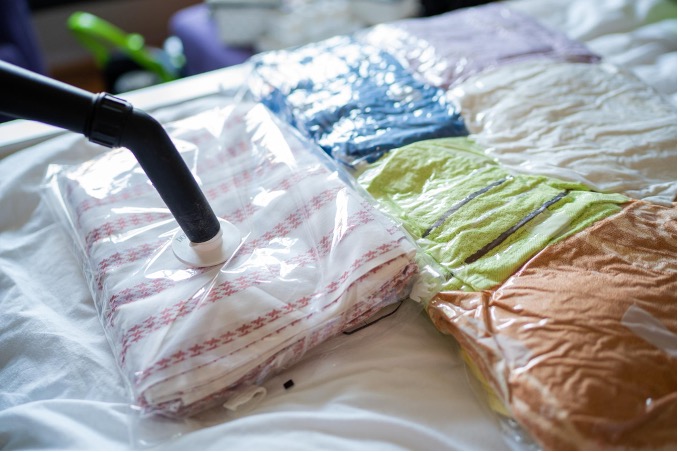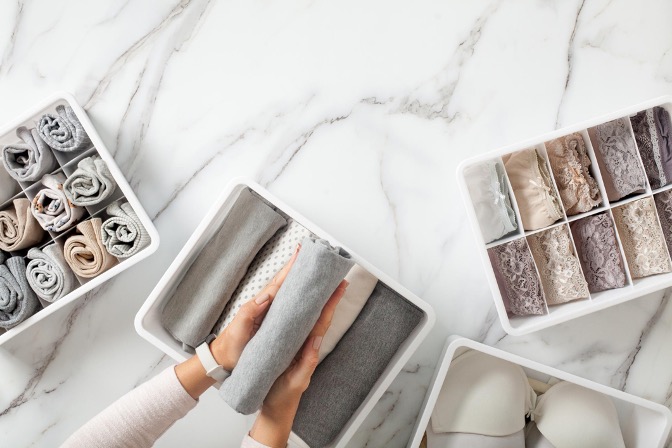If you store clothes with a top-notch storage unit company, you want them to come out in the same condition they went in. Move.org talked to half a dozen fashion and storage experts to see what works—and what doesn’t. We came up with 10 tips to help you store your clothes like the pros.
How to Store Clothes in a Storage Unit
For over 8 years Move.org experts have examined pricing, credentials, and real customer reviews to give you (human) recommendations you can trust. See how we review.
Kurt simplifies moving with nearly a decade of research experience. His writing appears in USA Today, Slate, and Martha Stewart Living. He holds an MPA.
1. Wash your clothes
Make sure to wash your clothes before taking them to a storage unit. This is about more than avoiding odd smells. It’s about having clothes you can still wear when you take them out of storage. Dirty clothes lead to mold and mildew—and that’s a death sentence for your clothing.
2. Don’t vacuum pack
It can be tempting to vacuum pack your clothes to save space, but it’s not a good idea. We asked Elisabeth Miller, a storage professional and quality supervisor at Move N’ Go what the fuss is all about, and she pointed out several problems.

You can save space vacuum packing, but it can also damage your clothes.
“Vacuum packing causes wrinkles and fabric damage because they need air to breathe,” Miller says. “By taking the air away, deterioration speeds up, ruining your clothes.”
Translation: Vacuum packing is a big no-no.
3. Don’t mix fabrics
One of the most common clothing storage traps is to store different types of clothes in the same boxes. It might be quick and easy to throw everything into the same box, but it also increases the chances of damaging your clothing.
“Natural fibers need to breathe in order to stay looking new and fresh,” said Miller. “Segment your clothes according to fabric, and make sure that any delicate materials receive the attention they deserve.”
There are practical reasons for this too. Just imagine how itchy things could get if you stored your silk undies with your wool sweaters. Yikes.
4. Know when to hang and when to fold
Hang or fold clothes in your storage unit just like you do at your home. You probably don’t want to fold your expensive blouses—or use a hanger for your workout shirts. The idea is for your clothing to come out of storage looking as good as it did when it went in.
Here are some items you most likely want to hang in a storage unit:
- Blazers
- Blouses
- Button-ups
- Dresses
- Dress pants
- Easily wrinkled clothing
Here are some items you most likely want to fold (or roll) in a storage unit:
- Baby clothes
- Leggings
- Pants
- Stretchy clothing
- Sweaters
- T-shirts
- Underwear
- Workout clothes
5. Roll your clothing
It may be second nature to fold your clothes, but they hold up better in storage if you roll them. Dave Bowden, a fashion writer at IrreverentGent.com, told Move.org that there are tons of benefits to rolling your clothing.
“Folding is fine at home when you’re going to be wearing something frequently, but after months of storage, those folds could turn into creases that are hard to get out,” Bowden said. “Rolling clothes often means they take up more space in storage, but it’s a much better option for the clothes.”

Prevent creases by rolling your clothes instead of folding them.
6. Put heavier clothes on the bottom
You can extend the life of your clothing by putting heavy items at the bottom of your storage box. For example, if you have a box for sweaters, put the bulky winter clothes on the bottom and the cute, thin ones on the top. Not only does this help prevent creases, but it also allows your clothes to breathe. And that’s a good thing.
7. Use plastic bins
The best storage containers for clothes are typically plastic bins. Cardboard boxes are cheaper, but they also don’t protect your clothing from humidity or water damage. It’s even worse if you use second-hand cardboard boxes because they might come with bacteria—or pests.
A plastic container doesn’t have any of these problems—especially if you get the right one. Laurice Baldwin, a co-founder of the fashion blog, ClothedUp, told Move.org she recommends plastic bins with lids that snap shut and keep out dust, germs, and water.
8. Buy wardrobe boxes
Wardrobe boxes are perfect for clothes you normally keep in your closet—like dresses and blazers—and the taller ones even come with racks so you can hang everything up. You can also get plastic containers without hanger racks that work great for seasonal clothing like winter coats and rain jackets. It all depends on which clothes items deserve more attention than others.
9. Use cedar chips
Throw some cedar chips (sometimes called cedar balls) into your clothes storage containers to scare away bugs. The last thing you want is to get your clothes out of storage and see creepy insects munching on them.
“There is a high chance of your clothes being exposed to a moth infestation,” Elisabeth Miller of Move N’ Go told Move.org. “Cedar chips will help deter any pests and keep your clothes protected.”
Cedar chips usually smell better than traditional mothballs, too.
Mothballs are a pesticide used to keep away bugs like moths and silverfish (a nasty-looking insect).
10. Get insurance
Purchase storage unit insurance for your clothing in case something goes wrong (like a break-in, fire, or flood). The more valuable your clothes, the more insurance you should probably get. Most storage unit companies have several insurance plans you can pick and choose from.
“It’s typically very affordable. I paid about $10 a month to insure a couple of thousand dollars worth of clothes,” Miller said. “Making sure you purchase insurance can give you peace of mind—especially if you’re storing valuable items.”
How to store clothes in a storage unit FAQ
A climate-controlled storage unit is worth considering in three situations:
- You need to store your clothes for a long time.
- Your city has extreme temperatures.
- Your clothes are expensive or sentimental.
Yes, most self-storage units sell insurance plans when you rent a storage space. You can pick and choose the coverage amount that’s best for your clothing storage.
You keep your clothes safe in a storage unit by choosing a reliable storage facility, following practical tips, and purchasing storage unit insurance. You can also opt for climate-controlled storage if you live somewhere with high humidity or extreme temperatures.
Yes, you should use plastic storage containers for your clothing items. While cardboard boxes are cheaper, they don’t offer the same protection as plastic totes.
Yes, you can store seasonal clothes in a storage unit. However, if you need long-term storage, it’s a good idea to check your boxes every couple of years to prevent creases and bugs.
To prevent mold, make sure there's no moisture in your clothes. Dry them thoroughly before storing, and make sure that no humidity can reach them by storing them in a plastic tote or secured box.
